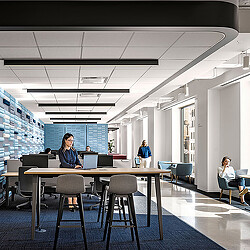Agency Is the New Workplace Amenity
By designing enough of the right spaces within the workplace, employers can create environments where employees have agency to choose the best space for their needs.

Note: This is the second blog of a series unpacking the detailed findings of Gensler’s Global Workplace Survey 2025. Read part one here.
How do you choose a space to work? Do you opt for a quiet corner to focus or a secluded spot to minimize disruptions? Do you grab the first available conference room, regardless of its size, technology, or location? Or are you a creature of habit, always choosing the same meeting space with the comfortable chairs, even if it means dealing with subpar AV equipment? According to Gensler’s Global Workplace Survey 2025, the answers might surprise you.
Today’s workforce needs a workplace that truly works for them. It’s no longer enough for workers to be tethered to a single desk or conference room. Instead of a one-size-fits-all workplace, we must design for purposeful abundance — providing enough of the right spaces for employees to choose the best space to match their daily work activities, when and where they need them.
Choice Is at an All-Time High
Choice has significantly increased over the years. In 2016, only 27% of employees in the U.S. had a choice of where to work. In post-pandemic workplaces, 76% of employees report having the freedom to choose their work settings within their office environment. Additionally, access to spaces for six critical work activities has improved — with 80% now reporting access to spaces to work with others in-person when they are in the office.

Is How People Decide to Work Leading to the Best Choices?
Interestingly, 44% of employees have agency to choose spaces to work within the office based on availability rather than comfort, ergonomics, acoustic privacy, convenient location, layout, or technology. In fact, this figure rises to 51% for those employees working in newer workplaces that have been upgraded, renovated, or relocated in the last three years. This suggests that workers may not be considering whether a workspace is fit for purpose and other important factors when selecting space within the office environment. For example, it’s not uncommon to see a confidential meeting of two people in a large conference room simply because it’s the only available space.
When availability is not a constraint, comfort, ergonomics, acoustic privacy, and convenient location become the top considerations. This indicates that while availability is a primary driver, employees do consider other factors when they have the option. Therefore, the challenge is not just making decisions about where to work but ensuring that the workplace is optimized to support these decisions.

Design for Purposeful Abundance
Employers need to provide enough of the right spaces for employees to choose the best physical environment for their work activities. This isn’t about being wasteful with unoccupied meeting rooms, but creating a feeling of abundance that spaces are available when needed. This means:
- Understanding Workforce Needs: Employers should understand how their workforce works and design spaces that not only match their work activities but also provide enough of each space type. Different types of group work require different types of spaces, ranging from rooms with soft seating to flexible spaces to co-create to typical conference rooms.
- Monitoring and Adjusting: Employers should continuously monitor how spaces are used and adjust to meet evolving needs. This includes designing flexible or modular spaces that can be repurposed or resized, much like retail spaces that adapt to changing demands. Creating workplaces that are expected to evolve is a powerful concept that removes the pressure from employers to make places that have to be equally effective from the start of the lease to the end.
Designing a Workplace That Works for Today’s Workforce
Employees should focus on getting work done, not wasting time finding the right space or missing the opportunity altogether because space was not available.
Those employees who work in the best workplaces are 2.4 times more likely to report that working in the office positively impacts their team’s productivity and the quality of their team’s work or services. By designing for purposeful abundance, employers can create environments where employees are empowered to choose the best space for their needs.
Download the full Global Workplace Survey 2025 to explore more insights and stay tuned for more blogs in this series.

For media inquiries, email .















